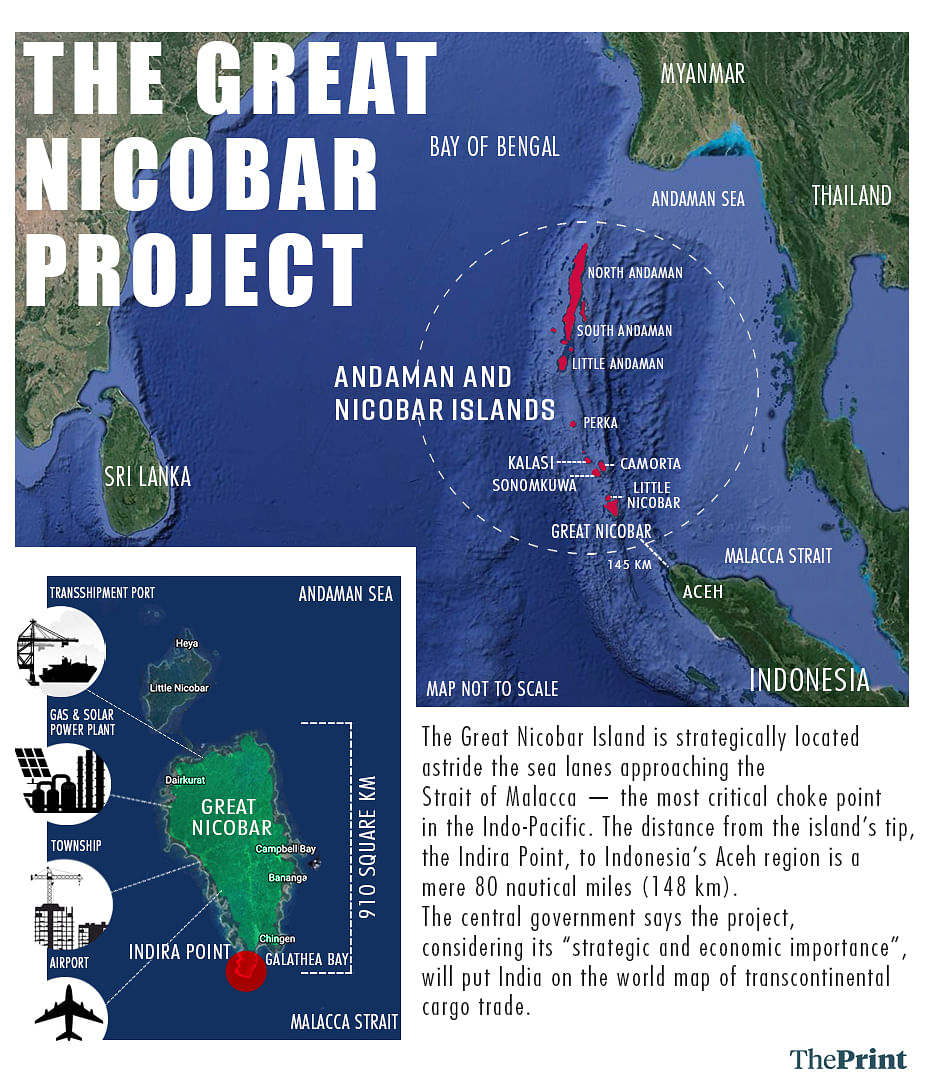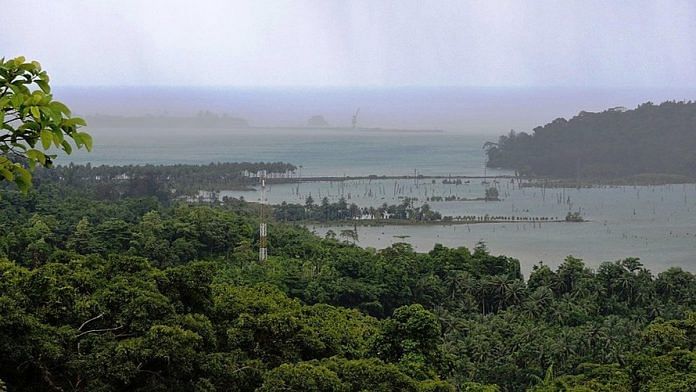New Delhi: Afforestation exercises in Haryana and Madhya Pradesh — to compensate for the trees that will be cut in the Great Nicobar Island to make way for the Modi government’s Rs 72,000 crore multi-development projects — is likely to start before monsoon season next year, an official in the Union environment ministry told ThePrint.
However, independent environmental experts are of the opinion that no amount of afforestation can make up for the loss of virgin rainforests and mangroves in the archipelago.
The ‘Holistic Development of Great Nicobar Island in Andaman & Nicobar Islands’ project is basically four ‘interlinked’ projects — a transshipment port, airport, power plant and township — which seek to transform the largely-uninhabited and remote island into a trading hub.
Earlier this month, the Ministry of Environment, Forests and Climate Change granted final clearance for the project, which will lead to the felling of at least 8 lakh trees in the Great Nicobar Island, home to two national parks and a biosphere reserve. Of the island’s 910 square kilometres (Sq. Km), 161 will be diverted for the project, including 130 Sq. Km of primary forest.
According to a pre-feasibility report on the project prepared for NITI Aayog and released last year, it will include the development of an international container transhipment terminal, which will eventually be able to handle 14.2 million TEUs (unit of cargo capacity); a greenfield international airport; a township; and a gas and solar power plant.
Last year, it was reported that the government of Madhya Pradesh had offered to provide land for afforestation for the project, since over 80 per cent of the archipelago is covered in forest. In 2019, the Union government had opened the doors for compensatory afforestation to take place outside the home state if it has a forest cover of over 75 per cent.
Madhya Pradesh has a forest cover of 25.14 per cent, while Haryana has a forest cover of just 3.63 per cent — the lowest in the country — according to the Forest Survey of India 2021.
“We have already allocated space in Haryana for the afforestation to take place. Some districts include Nuh and Gurugram. We are planning to start before the monsoon season next year,” said a senior environment ministry official who wished to not be named, adding that Haryana was chosen because of its proximity to the National Capital Region (NCR), and “the potential contribution the trees can make to improving the air quality in the area”.
The project was granted environmental and coastal clearance on 11 November, after the Expert Appraisal Committee (EAC) — an autonomous body under the environment ministry in charge of inspecting proposals — gave its approval in August. Notably, the clearance letter does not mention any location for afforestation.
The project has faced resistance from environmentalists who have warned against the destruction to rare marine and terrestrial ecosystems it will cause.
“The conditions on which the clearance has been granted state that studies on the megapodes, turtles and other species need to be done. But all of these should have been conducted before, during the EIA (environmental impact assessment) stage. Instead, they are being done after the clearance is given,” said Debi Goenka, executive trustee of Mumbai-based non-profit Conservation Action Trust, one of the organisations that had submitted its apprehensions to the Union territory government.

The central government meanwhile has justified the project citing its “strategic and economic importance”, and said it will put India on the world map of transcontinental cargo trade.
The Great Nicobar Island is strategically located astride the sea lanes approaching the Strait of Malacca — the most critical choke point in the Indo-Pacific. The distance from the island’s tip, the Indira Point, to Indonesia’s Aceh region is a mere 80 nautical miles (148 km).
According to the pre-feasibility report, “the main east-west shipping route that links East Asian exports with the Indian Ocean, Suez Canal and Europe runs just to the south of Great Nicobar Island.”
This, an issue brief by researchers with the Observer Research Foundation has said, is significant for India, since it can “play a vital role in ascertaining maritime security in the region, especially in terms of maintaining freedom of navigation. This is because the Andaman and Nicobar Islands straddle the Preparis Channel, the Duncan’s Passage, the Ten Degree Channel and the Six Degree Channel, all of which are important shipping routes for India as well as other shipping destined for East and Southeast Asia.”
By building a container port in this location, “India can participate more fully in the global shipping trade,” the report for NITI Aayog adds.
Also Read: In a historic first, rich countries will pay for losses and damages caused by climate change
Conditions for clearance
According to the clearance letter, the project threatens the nesting site of the endangered Leatherback Turtle in the Galathea Bay of the Great Nicobar Island, where the transshipment port is designed to come up. It will also destroy at least 30 nesting sites of the vulnerable keystone Nicobar Megapode bird species.
Documents available on the PARIVESH portal — a website tracking proposals for environment, forest, coastal and wildlife clearance — show the clearance was awarded with over 40 conditions. One of them was that the Wildlife Institute of India establish a long-term field study to monitor turtle-related research for 30 years, until 2052. It also ordered research into the Megapode’s population, translocation, and disease vulnerability.
They also stipulate that the project proponent, the Andaman and Nicobar Islands Integrated Development Corporation Ltd (ANIIDCO), release budgets for studies into the impact of invasive species, conservation of endemic species such as the Nicobar Macaque and Robber Crab, as well as coral and mangrove translocation and conservation.
Of the 130 Sq. Km of forest land that will be diverted, 84 Sq. Km fall within a tribal reserve — home to the Shompen and Nicobarese tribes — which will have to be denotified.
The clearance is contingent upon the condition that the project “shall not disturb Shompen tribe and their habitations”. It also necessitates a welfare board for the Shompen and Nicobarese tribe be set up to tackle their “issues”.
Also Read: UN report has grim warning on global warming: Latest pledges ‘nowhere near’ meeting targets
Apprehensions remain
In June, the EAC had pointed out several gaps in the EIA report on the project submitted earlier this year, including the failure to provide a plan for mangrove and coral conservation, and said that several of the EIA’s terms of reference (TOR) — which outline the criteria required for the impact assessment — were not met.
According to the environment clearance letter, the ANIIDCO made a submission to the EAC saying it has allocated money towards planning these aspects, following which clearance was granted.
However, concerns that the afforested tree plantations won’t provide the same ecological services as virgin rainforest and mangroves do remain.
Haryana is characterised by a dry and arid climate. The Andaman and Nicobar Islands are also vulnerable to the effects of rise in sea-level and seismic activity.
“No afforestation can make up for lost virgin rainforest,” said Goenka. “When the effects of climate change are upon us, we cannot afford to lose any amount of forest. It cannot be called sustainable development when we destroy nature and replace it with infrastructure that doesn’t preserve ecosystems.”
Rajesh Thadani, founder of the Centre for Ecology Development and Research said the values of forests go beyond just the absorption of carbon dioxide.
“Forests maintain biodiversity, help prevent coastal erosion, and their destruction could have very damaging consequences for coastal coral reefs. The forests of Great Nicobar are among the richest for diversity and endemic species — species found nowhere else on this planet,” said Thadani, adding that planting in Haryana will have none of these benefits and that “if Haryana is serious about forests, it would be better to agree to protect existing forests such as Mangar, an old forest that provides critical ecosystem services to Delhi.”
“Development must happen and some amount of forest loss may be necessary for strategic reasons, but in this case, it would be better to spend the money earmarked for compensatory afforestation on the construction technologies that minimise ecological damage and lead to a more compact development project that would reduce the amount of primary forest loss,” he said.
(Edited by Anumeha Saxena)
Also Read: 1% of global population caused 23% of growth in carbon emissions from 1990-2019, study says



